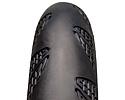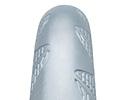
Recently on Cyclingnews.com |
Tech News – August 15, 2005Edited by John Stevenson Got tech? Send press releases, news, and tech questions to the Cyclingnews tech desk. Continental unveils Vectran-protected clincher
As previously hinted on Cyclingnews, German tyre stalwart Continental has released the first clincher road tyre to utilise the high-tech material known as Vectran. Conti rolled out Vectran-layered tubulars at Paris-Roubaix earlier this year and it was that confident of its new product, it even invited a group of cycling journalists (and cobbles novices) onto the famous parcours to test them. Nobody flatted, or fell off, for that matter, and the next day, the company reported a 75 percent reduction in flats recorded by its sponsored teams (see technical report). Continental has pioneered the use of Vectran and spent the past two years working with the material's developer to make it work in bicycle tyres. It made no secret of using this material in its tubulars, even allowing factory visits to watch the handmade tyres in production, but the clincher section of the factory was strictly no-go, Jack.
But at the time, it was an obvious application of what appears to be a very useful material. Vectran is said to offer "a balance of properties unmatched by other high performance fibres", like Kevlar. Continental claims Vectran is five times stronger than steel, yet more flexible and cut resistant than Kevlar. The material has been developed over 30 years and Continental has taken out patents to protect its work applying it to the unique requirements of lightweight, low rolling-resistance bicycle tyres. Conti has decided to introduce Vectran by superseding the faithful Grand Prix 3000 with the GP4000; this not only features Vectran, but a new "Activated Silica Compound" tread. This new formula is claimed to offer what are usually mutually exclusive properties - good grip, low rolling resistance and long life. The GP4000 also has tread-wear indicators and a distinctive tread pattern like the fancy GP Force & Attack tyres (see review). But unlike the 'matched-pair' approach of the front wheel-only Force (22mm) and rear wheel-only Attack (23mm), the GP4000s will come in 20, 23 and 25mm sizes.
But wait - there's more. Conti has also applied the "Xserallic" colours for metallic shine in the GP4000. These pigments are widely used in the automotive, cosmetics and mobile phone industries and again, Conti is the first to use them in bicycle tyres. Consequently, there is a bewildering array of colour combinations (okay, 11) that should suit the most colour-coordinated riders. The casing of the GP4000 is 110tpi (threads per inch) nylon cloth - the same as used in the GP3000; said to be the "perfect compromise" between cut resistance and flexibility. We could also quote otherwise meaningless metrics that point to higher puncture protection and lower rolling resistance, but we all get this one - the GP4000 is 205 grams per tyre, five grams lighter than the GP3000. The tyres have been tested extensively in South Africa and Australia to see how they cope with heat and light and will be available in retail outlets this month.
Continental supplies new tubulars for the Tour
At the Tour de France, teams such as T-Mobile, Phonak, Crédit Agricole and Saunier Duval teams were rolling on new Continental racing tyres that contain new compound materials. According to Conti, the use of the liquid crystal fibre Vectran means the racing tyres - handmade in Conti's Korbach factory (see feature) - are more puncture-resistant, but also weigh less and offer reduced rolling resistance. Continental debuted the Vectran-layer tyres at this year's Paris-Roubaix in special 25mm versions designed for brutal cobbles of the 'Hell of the North' (see report). But there are now three options of the Competition Pro family that were used in the Tour: the Competition Pro Limited Allround, which features a compound that is particularly suitable for fast riding on the flat and in the mountains; the Competition Pro Limited Rain is designed for use in wet weather, while the Podium Pro Limited, which weighs just 220 grams, offers low rolling resistance and is suited to time trials. The different compounds used are designed to provide optimum grip on wet and dry roads. In the Tour, the difference between victory and defeat can be a matter of seconds, which means the tyres - weighing just 250 grams - are an important part of the overall bike concept. "Choosing the right tyres for the Tour de France is by now as much of a gamble as in Formula One," said Wolf vorm Walde, product manager at Continental. For further information see www.conti-bicycletires.com. |





